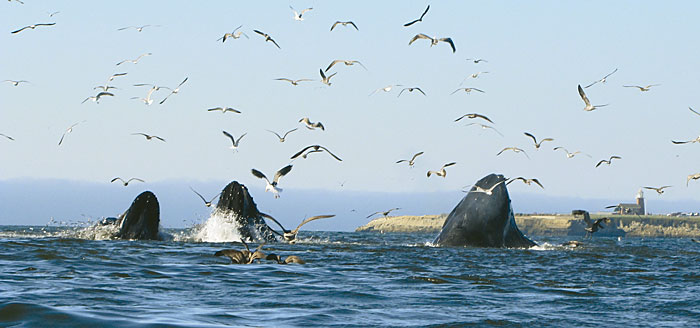Humpback whale visit poses eco-ethics questions
December 2011

Three Humpback whales feed off West Cliff Drive in Santa Cruz. Federal law requires people to stay 100 yards away from marine mammals. Photo: Jenna Slovis
by David Casterson
Based on its rich biodiversity, the Monterey Bay National Marine Sanctuary has been described as the "Serengeti of the Sea." A perfect intersection of conditions led to a magical two-week cetacean-human experience this October.
In the fall, upwelling of our nutrient-rich waters drives a bloom of plankton. Anchovies often move into the shallow waters of the inner Bay to utilize this abundance. This year, a pod of humpback whales (Megaptera novaeangliae), part of the population that migrates annually between Oregon and Mexico, happened to arrive when this was all taking place. Humpback whales weigh 50-80,000 pounds, reach a length of 50 feet, and can live over 60 years.
Humpbacks use their fringed plates of baleen to filter tiny plankton-feeding crustaceans from the water and also feed on small fish such as anchovies. This provided a unique experience for many of the humans living in the Santa Cruz area.
Unaware of the presence of whales, naturalist Kim Powell was leading teacher Jane Orbach and 14 of her San Lorenzo Valley High School students on a kayak trip just off the Santa Cruz coast. The students were about to begin a lesson on kelp forest ecology when Jane yelled, "Kim, there's a whale!"
Powell recalls,
"It was an extraordinary educational moment that required no words. The humpbacks were center stage, and the students witnessed an array of behaviors from pectoral fin slapping to the most impressive behavior of all, a breach, when a whale propels its body out of the water followed by a dramatic plunge downward. Lingering in our memory bank will be the unforgettable scent of anchovy breath expelled through the blow hole of an exuberant whale. As we paddled back to shore, one student proclaimed, 'This has been the best day of my life.'"
When Powell kayaked a few days later with a friend off the Santa Cruz wharf, she stopped paddling and drifted near where she had seen the whales. She describes what happened:
"Without warning, a pod of very energetic sea lions surfaced and rocketed towards us, leaping out of the water, a behavior known as "porpoising" which occurs when seals pursue prey or are being pursued by a predator such as a White Shark or Orca. The prey, in this case were anchovies feeding on a rich plankton soup."
"We immediately back paddled and started tapping our plastic vessel to make any stealthy cetacean visitor aware of us as we drifted away. Then one of the most incredible moments of my 27 years as a naturalist occurred: a humpback whale gently raised its head out of the water approximately five feet from us. This astounding behavior, known as 'spy hopping,' occurs when a whale approaches an object such as a boat to take a better look."

The Santa Cruz Boardwalk provides a backdrop for these Humpback whales in October. Photo: Kim Powell
"As quietly as it had arrived, the whale sunk back below the blue-hued sea. I struggle to find the words to express the feeling that flooded through every pore of my body. We were in awe and overloaded by the adrenaline that pulsated through us."
As with the student encounter, the Humpbacks were curious, their behavior suggesting that they were not disturbed by the presence of humans.
On Sunday, October 30, the situation was quite different. Kim writes,
"The scene as we departed Santa Cruz Harbor will stay with me for years to come. Federal law requires people to stay 100 yards away from any marine mammal but, unexpectedly, immediately upon leaving the harbor, we found ourselves too close to the feeding humpbacks. Interest in the humpbacks had exploded and there were maybe a hundred watercraft in view; it was ecotourism gone awry. The image of human bodies standing upright on boards, kayakers, boogie boarders, surfers, sailboats and motorized skiffs continues to haunt me."
Proper etiquette in sharing sanctuary waters
Marine mammals routinely swim toward humans watching from the 100 yard legal distance, and it is often necessary to be able to retreat. When a 'feeding hot spot' develops close to a kayaker, a few quick paddle strokes can move a kayaker to a safe and legal distance from surfacing marine mammals. If you can't maneuver your watercraft in this fashion, you are too close! Rapping the side of your watercraft signals feeding animals of your location.
Pacific Humpbacks were slaughtered by the thousands along our coast beginning in the mid 1800s. When a moratorium on whaling was enacted in 1966, their population hovered at about 1000. Now, 45 years later, they number approximately 20,000.
Of these, 2000 make up the Oregon-Mexico population that we see on the Central Coast. These humpbacks migrate annually to give birth in Banderas Bay, just north of Puerto Vallarta Mexico. The 2006 SPLASH study suggests that humpback populations are increasing at a rate of approximately 6% per year. Humpback whales remain on the U.S. Endangered Species list, with entanglement in fishing gear, collisions with ships, and noise pollution major concerns.
In the aftermath of the Humpback visit, many questions remain. Why do they alter their feeding lunges to avoid humans? Was their visit just a lucky combination of conditions or is it part of a larger trend? If and when they visit our inshore waters again, will we humans be able to give them the space they deserve?
< back to all issues

